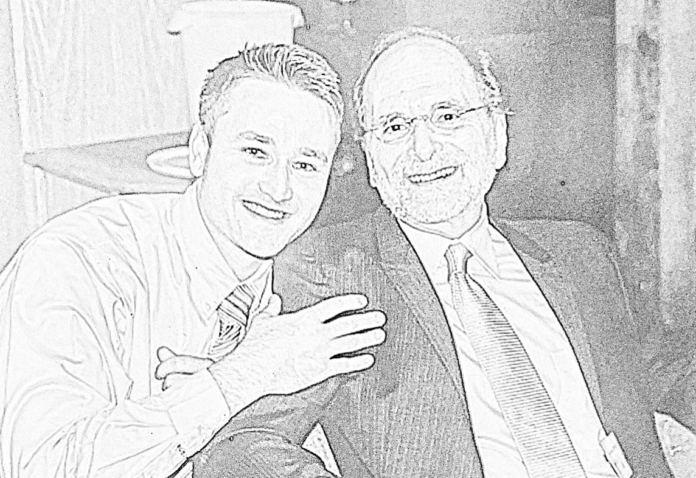— a Skorman/Kieding amalgamation perspective
In couples therapy, you are initially dealing with needing to establish two separate conscious therapeutic alliances that have enough overlap so that there is a shared vision for what changes they each aspire towards. This shared vision, if it is there, make up the foundation of the treatment. Some courses of treatment are short and end after it becomes clear this common ground simply is not there, meaning there is not a sufficient foundation for proceeding with couples therapy. Sometimes there is a shared vision but the vision fall outside the parameters of what couple therapy can accomplish.
The couples where one partner wants to learn how to get better at being submissive so as to not anger the other, the couple where the idea is that it is all up to just one partner to make the relationship better, or the couple where they want to learn how to never be triggered or have feelings come to mind as examples of where the couple may have common ground, but their vision falls outside the scope of what is possible or ethical to go along with.
The partners making up the couple may be in couples therapy for different reasons, or one may not even want to be there at all. You have to attend to all of that. In addition to your own, you are dealing with two triangles of conflict.
The difference with couples compared with individual therapy is that the couple stir up each other’s feelings, you don’t have to mobilize people to have feelings, they are doing that for each other after a few minutes of niceties. And your job is to then to work with the triangles of conflict in each of them, to see how they are dealing with their respective feelings so that each can begin to see what their role is and what their contributions are to the problems (distance) in the relationship.
So the benefit of couples work is that you don’t have to stir up feelings, they do that themselves for each other. The more difficult part is that you have two triangles of conflict, two sets of defenses interacting with each other. That is the more difficult part.
Fostering emotional intimacy
If, in your capacity as the couples therapist, you are acknowledging one partner’s feelings as being valid (but not necessarily how they deal with their feelings), then you also want the other partner to do the same thing. Fostering this mutual validation and acknowledgment of the other’s feelings is critical, and it can sound like this:
“Does it make sense to you that he would be angry when you scold him, that he would not like that? How he deals with his anger needs work, but does it make sense to you that he doesn’t like that?” And vice versa so that each get a turn to be heard and acknowledged.
Instead of talking about intimacy and closeness in the abstract, you want to say out loud what it would look and sound like if they were being emotionally intimate.
For example:
Therapist: “So how would it work for you if instead of scolding and lecturing you, she just said it makes me mad when you do that, and then stopped. And didn’t try to change you or harangue you. Would that be an improvement?”
And as a follow up: “Could you then support her anger, since you think it’s reasonable for her to be angry? So instead of defending yourself you acknowledge that you can see why she would be angry. It doesn’t mean you have to change anything or even agree with how she sees this, it just mean you are acknowledging that her feelings are reasonable based on who she is and her recollection of events. How would that be for you?”
Here the partner addressed typically acknowledges that this would be an upgrade.
Then turning to the other partner: “And how would it be for you if he did that for you?” Partner: “Great.”
The therapist might continue like this:
“OK, so then, by scolding him in an off-putting way, you are cutting down on the chances of receiving that support and acknowledgment. Because he will just be pissed at you for reading him the riot act.” The partner being addressed responds that they understand. The therapist can continue:
“And so this kind of acknowledgement — where the other says, ‘Though I don’t like how you dealt with your anger, I can understand why you are angry with me, I don’t blame you for feeling that way” — is something you haven’t had much in your life, but do you see how by virtue of how you deal with your anger, it makes it less likely that you will get it. Whereas if you just say you are angry, stop, and then give him space, do you see how the odds improve that he might acknowledge that he can see why you would be angry? Do you see how much more gratifying that would be for you? How much easier?”
When you are suggesting changes to one partner, you want to make it clear that those changes are not being suggested because the partner would like those changes, but for the benefit of the person being addressed. Though the wife is likely to like it much better if the husband stops lecturing her and instead calmly declare his anger, it must be clear to the husband who receives the insight and suggestion that giving up ‘lecture mode’ will actually be better for him and make his life easier, and that though his wife will appreciate the behavioral change, that is not why we are suggesting it.
We are making the suggestion because instead of being defensive and lecturing, it is easier to just say, ‘I can see why you would be angry at me for lecturing you, and is this a good time to talk about why I am angry at you?,’ With communication like this, you don’t have to spend hours, days, or weeks being defensive.
This intervention may sound like this:
“Even though your wife would like it better, that is not why I am suggesting it — I would never suggest you do anything of this magnitude just to make your wife happy, it has to be best path for you. Smaller things like how you load the dishwasher, that you can do as a favor to her if you want, smaller things like that, but these are big things having to do with who you are, how you feel, and how you deal with emotions in your life.”
In terms of the central task of fostering emotional closeness and intimacy, it’s important to remember that when you use the word intimacy, people often think of that as just positive feelings or as a euphemism for sex. Therefore it is important to role model what an emotionally intimate interaction could sound like by injecting commentary.
For instance: “if you were being intimate right now, you could say this, and you could respond in this way.” It’s a kind of teaching of skills, but it has an experiential component since you do it in real time connected to their actual interaction and behaviors, so this kind teaching of skills has a restructuring effect. Defenses and maladaptive behaviors get restructured. It’s important to make clear that emotional intimacy is just about acknowledging and conveying to the other what is going on inside of you, without acting out or pressuring anyone to change or be different in a way, where everyone ends up feeling heard and acknowledged.
Emotional intimacy doesn’t require that you agree with the other, you can have emotional intimacy even around strong disagreements. “Here is what I am thinking and feeling. Here is what I would like, but how would that be for you?” That is intimacy, the act of allowing someone close to the truth of our experience while still leaving room for the other’s experience. The opposite — being defensive and distancing — usually involves some version of treating the other like they should be an extension of ourselves, some version of ‘Here is what I think, end of discussion,” or, “Here is what I want,” with the implication and therefore you should do what I want. In this distant mode, what we think, feel, and want counts more than what the other person thinks, feels, and wants.
So we try to foster emotional intimacy between the couple, which amounts to clarity about what they each feel and want, while leaving room for a two-person relationship.
Are skills taught?
Skills are being taught, but the function of the teaching of the skills — which is often in the form of the therapist role-playing and modeling emotional intimacy through commentary — is not just about helping the couple acquire new skills (though it is also that), but it also includes that the couple are able to see in concrete terms what you are shooting for in terms of emotional intimacy.
“Here is what interactions between you can look like if our therapy is successful. You would handle your feelings like this instead of that, and you would handle your feelings like that instead of like this.”
This also strengthens the conscious therapeutic alliance. So this is a different approach than couples therapy that consists of proposing date night or putting a chore list on the fridge. It’s not just behavioral, it really restructures how the couple communicate. And that is often enough to improve things enough where the couple feel ready to end treatment.
Learning new skills in an experiential way has a restructuring effect, so the mechanism of change is a combination of a number of factors: gaining insight into maladaptive interactional patterns (defenses and resistance against emotional closeness), restructuring defenses through a focus on the underlying emotions, while at the same time also learning and acquiring new skills.
What role does unlocking the unconscious have in ISTDP-informed couples therapy?
They can come spontaneously. You don’t want to push for unlocking the unconscious in couples therapy, you want to wait till the wife says, “Oh god, I am so mad” — gesturing her hands in a manner that suggest the urge to strangle, for example. Then you can say “what do those hands want to do?” And typically unlocking come after you have been working for a while.
An unlocking effects both people. If the partner is not ready to hear and witness that, it can be a major problem. So most unlockings are spontaneous, after a lot of identification of defenses, anxiety, and restructuring of defenses in both parties.
In my work, whenever one partner has an unlocking, the observing person has been really swept up in it and felt closer to their partner, even though they were murdered in fantasy (and then they turned into a genetic figure).
But you always check in with the observing partner: “So how was that for you?” You don’t just stay with one person, you go back and forth to make sure they are both there.
“How was that for you? And how was that for you?” Invariably the person who witnesses the other having an unlocking feels closer to them. Their response usually contains the sentiment:“Oh, it wasn’t just me, it was also about his mother, and I feel closer to him now.”
So when I ask, “He or she just derived satisfaction from the imagery of murdering you, is that better for you than when they scold or lecture you?” Invariably they say, “Much better.” It brings them closer together as a couple.
But if you are pushing for it right away at the beginning, it can be really bad. I heard about a couple who saw an ISTDP therapist and in their second couples therapy session, the male partner had an unlocking in the session, and it freaked out the female partner. She became panicked. She broke up with him, she was not ready for it. You have to really be sure both are ready for an unlocking, not just the person who is more mobilized.
The triangle of person
With an unlocking, you have the “So you mean it’s really your mother. Compared to how your wife is critical of you, how does that compare to how your mother was critical? The patient often says, ‘oh, there is no comparison.’ So then, you mean some of the anger at your wife for scolding you is not just for her, but for your mom? Your wife was getting your mother’s share of your anger, only no one realized it.’” That’s very unburdening for the wife, or the person who was getting more than their fair share of anger.
Or when people have the defense of blaming and using the other’s behaviors as a reason to not be emotionally authentic, i.e. “I can’t be honest with my husband because he loses his temper, so I have to not say certain things to him,” then the person will be doing that with me, and I will say, “so now you are pulling your punches with me, like you do with him, and I haven’t scolded you or lost my temper, maybe this is just how you are in relationships. Were you this way before you met your husband?”
Often the answer is yes. So then you can turn to the husband and say, “So you are a good cover because you are a jerk sometimes in terms of how you deal with your anger, but do you see that you did not cause this? This is how she is with me too, so that tells us that this is how she would be no matter what — you are just easy to blame, because you do lose your temper.”
So if either partner are engaging defensive behavior with you in the transference (the “T”) that they also do with their partner but are blaming their partner for, that is a gift because then you can see that they are doing it with you too.
So then the intervention can go like this:
“Then this is how are you, how you distance with everyone. If this relationship doesn’t work out, this is how you would be in the next one too, unless you deal with it. So why don’t we take whatever remaining time of your marriage, which may be a few months or a few years, who knows, and work this out. That way if the marriage ends, you won’t be this way in your next relationship, and if the marriage lasts, you two can have a much more satisfying relationship.”
Most of the things that people get really angry at their spouses for is because it is connected to core unresolved feelings from their past. Of course there are exceptions, partner behavior that are just really bad in and of themselves. But you are always looking for the transferred and displaced material. Like, ‘geez, this should be annoying, this doesn’t warrant such an intense reaction,’ you have to suspect there is something going on from the past. And sometimes you can get to that without an unlocking. Just by saying, “Well that doesn’t add up. I can see why you would be mad, but the intensity seems out of proportion, what is going on? Is this the first person in your life who does this, or have other people from your past also done such and such.” And they often go, “Oh, my mother was that way.” And then they can understand, just intellectually, that some of the anger is about their mother and not the husband.
Are we going for resolving their neurosis or just helping them have a better life?
We are going with their definition of treatment, as long as that is within the parameters of what can be accomplished in couples therapy. Typically it will be improving the marriage, but that often goes in the direction of restructuring defenses — typically not full character change — but enough restructuring of the defenses and access to affect that the marriage is good. And this can generalize to improved relationships beyond the marriage or primary partner.
Sometimes you can help fix the marriage or relationship without any unlocking or intense experiential restructuring. The therapy gods line up somehow and in a few sessions they are done — some dynamic between them is shifted and that is sufficient, they come in after a few sessions and they are getting along fine. And if it turns out to not be sufficient, they will come back.
In summary
Making sure we understand each of their respective priorities for treatment, making sure there is enough overlap between their respective priorities so that there can be a foundation for treatment, and making sure that the shared vision falls within the scope of what ethical couples therapy can accomplish, is foundational. Assuming all of that lines up, looking at specific examples and beginning to help each partner see their own triangle of conflict is often the next step. At that point we often need to establish additional conscious alliances around giving up the specific defenses and behaviors in favors of having feelings and expressing those feelings in ways that are appropriate and emotionally intimate. And letting unlockings happen organically rather than pushing for them is also an important element in this way of working.
This is a very brief and far from exhaustive sketch of some of the core components and considerations involved in the Skorman/Kieding perspective of ISTDP-informed couples therapy.


 I have a passion for practicing ISTDP informed psychotherapy and I enjoy writing about it. For more information and what I do, visit my website: www.johanneskieding.com
I have a passion for practicing ISTDP informed psychotherapy and I enjoy writing about it. For more information and what I do, visit my website: www.johanneskieding.com


















